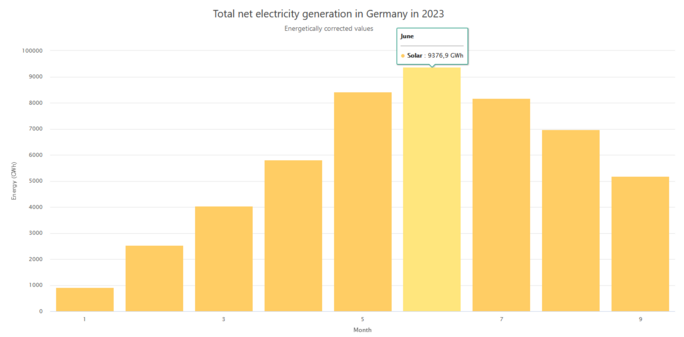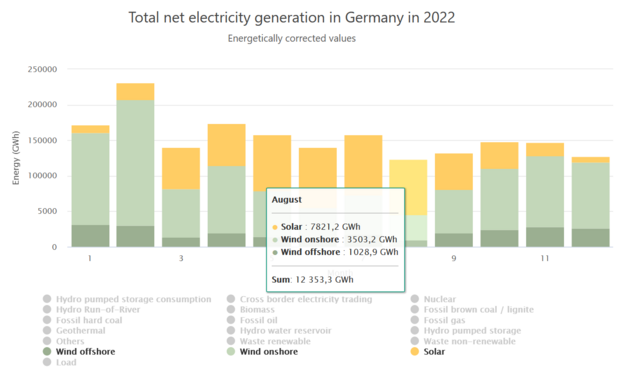Recent searches
Search options
"""
Economy Minister Robert Habeck has for months pushed for an energy subsidy scheme, arguing that German industry faces five tough years before the transition to renewable energies bears fruit. The top Green politician has warned that, without state support, "we will no longer have industry," as companies would shift operations to countries like France or the U.S., where energy prices are much lower.
"""
https://www.politico.eu/article/germany-energy-price-subsidy-industry-competition/
The panic about the economic stagnation is from the energy price shock (Russian gas disappeared) and the slow-down in China. But:
"These outside shocks have exposed cracks in Germany’s foundation that were ignored during years of success, including lagging use of digital technology in government and business and a lengthy process to get badly needed renewable energy projects approved."
https://apnews.com/article/germany-economy-energy-crisis-russia-8a00eebbfab3f20c5c66b1cd85ae84ed
@CelloMomOnCars One can only laugh at this point when reading passages like these:
"The government wants to have 215 GW of solar installed in Germany by 2030, more than tripling existing capacity in seven years."
Why laugh? Because 215 GW of #solar with 10% capacity factor (because it's Germany, not California) will roughly replace 20GW of #nuclear power that they retired since 2011. So many years lost...
@jackofalltrades @CelloMomOnCars 215/3 = 72 ish, so am laughing in *UK abject failure* where we have 14.4 GW installed and a population only 20% smaller
If it's any consolation, #solar at this latitude isn't so great anyway.
Germany currently has 75.17 GW of installed solar capacity.
In June solar generated 9376.9 GWh resulting in a capacity factor of 17%. Nice, right? Well, in January solar generated 917,5 GWh resulting in capacity factor of 1.7%.
The idea that solar can meet the energy needs of Germany is quite ill-informed IMHO.
For comparison, average solar capacity factor for the whole US varies between 13.1% in December and 33.4% in June.
Source: https://www.eia.gov/electricity/monthly/epm_table_grapher.php?t=epmt_6_07_b
@jackofalltrades @CelloMomOnCars that must be the southern states dragging the US average up, right?
@jackofalltrades @CelloMomOnCars although I note that even a northern state like Maine is at the same latitude as the Bordeaux estuary. I guess the US as a whole is a lot more south than I tend to think of
Yep. Comparing by latitudes the US spans roughly between Morocco and Italy. Germany and UK are at a similar latitude to southern Canada.
Despite the high altitude, solar is being developed in both Germany and famously rainy Netherlands.
I don't double-guess those developers, I assume they did their due diligence, and they would not be investing in solar in these regions if they didn't think there was money to be made!
The secret sauce: wind energy.
Wind and solar are complementary in NL and D.
@CelloMomOnCars @urlyman Indeed, it makes more sense when #solar and #wind are combined. However, the variability is still quite big.
Based on 2022 data, in Germany there was 68.5 GW of solar, 58.1 GW of onshore wind and 8.2 GW offshore wind.
If we treat this as a combined 134.8 GW system, we are going to get a spread of generation between 12,353 GWh in August (capacity factor 12.3%) and 23,105 GWh in February (capacity factor 25.5%).
BTW in Germany electricity demand is higher in the winter.
To again compare that with the US...
I dug the numbers for 2022 from EIA. US had 110.1 GW of solar and 140.9 GW of wind for a total 251 GW system.
Wind+solar generated 44,427 GWh in August (capacity factor 23.8%) and 64,523 GWh in April (capacity factor 35.7%). Both top and bottom bounds were decided by the wind output, as it generates more than twice the energy than solar.
Overall, the US gets double returns on their solar+wind investment compared to Germany or UK.
@jackofalltrades @CelloMomOnCars according to my maths and some digging, US energy consumption per capita is 1.76x that of Germany and 3.8x that of the UK.
US:
energy demand: 100.41 quadrillion Btu (2022)
population: 333 million
Germany:
energy demand: 14.29 qn Btu (2021)
population: 83 million
UK:
energy demand: 5.32 qn Btu (2021)
population: 67 million
My numbers are slightly different, but the general conclusion is correct.
2021 data for energy consumption:
USA: 88.52 qn Btu (25,945 TWh)
Germany: 12.1 qn Btu (3,549 TWh)
UK: 6.82 qn Btu (1,999 TWh)
Source: https://ourworldindata.org/grapher/primary-energy-cons?tab=chart&time=2021&country=GBR~DEU~USA
I can see that 100.41 qn Btu number listed on the EIA site: https://www.eia.gov/energyexplained/us-energy-facts/ though.
Would be nice to know the reason for the discrepancy.
@jackofalltrades @CelloMomOnCars thanks. Good to see that, as you say, the *relative* amounts are roughly the same.
And yes, the EIA was my US source.
So now check this out, 2019 data:
USA
avg engine power: 192 kW
avg kerb weight: 1768 kg
avg fuel consumption: 8.6 lge/100km
gasoline price: 0.79 $ PPP/litre
https://www.iea.org/articles/fuel-economy-in-the-united-states
UK
avg engine power: 110 kW
avg kerb weight: 1518 kg
avg fuel consumption: 6.3 lge/100km
gasoline price: 1.59 $ PPP/litre
https://www.iea.org/articles/fuel-economy-in-the-united-kingdom
German numbers are very similar to UK's.
The cheaper the energy the more wasteful people are with it, it's that simple.
Here's another interesting trend reversal: the lowest point for the average car fuel consumption in the UK was 2016. After that point Brits started buying bigger and heavier cars and the fuel consumption has been growing ever since.
The exact same thing can be seen in Germany.
@jackofalltrades @urlyman @CelloMomOnCars is there any more recent data? at least at the EU level, there was a big drop in 2020 when the 95g/CO2 fleet average became law, and AFAIK that was met.
@gsnedders @urlyman @CelloMomOnCars
Note that I was talking about fuel/energy consumption, not CO2 emissions. EVs can be wasteful too.
There is no data for 2020+ in that IEA report, but there are other reports, like this one from the European Commission: https://climate.ec.europa.eu/eu-action/transport/road-transport-reducing-co2-emissions-vehicles/co2-emission-performance-standards-cars-and-vans_en
"""
As the new target started applying in 2020, the average CO2 emissions from new passenger cars registered in Europe have decreased by 12% compared to the previous year and the share of electric cars tripled.
"""

@jackofalltrades @urlyman @CelloMomOnCars Ah, was unclear if it was measuring "fuel consumption" (as labelled, which is presumably 0 for a BEV) or "energy consumption" (which isn't!).
And sure, CO2 and energy consumption differ, but CO2 emissions is a very good proxy given for fuel consumption given for both petrol and diesel ICEs it's directly proportional.
@gsnedders @urlyman @CelloMomOnCars
"lge" is short for "litres of gasoline equivalent".
Based on 2019 data for the UK, averages for each type of powertrain were:
petrol: 6.7 lge/100km
diesel: 6.0 lge/100km
hybrid: 4.7 lge/100km
plug-in hybrid: 2.4 lge/100km
electric: 2.1 lge/100km
You can explore this data yourself at https://www.iea.org/articles/fuel-economy-in-the-united-kingdom
@jackofalltrades @gsnedders @CelloMomOnCars I infer that the lge for electric is a function of how clean (or not) the electricity it's charged from is.
In which case, it's kind of depressing to see that the lge in 2019 was slightly higher than in 2011. Wonder which winkers were in government during that period?
@urlyman @gsnedders @CelloMomOnCars
Not at all, lge is a measure of energy, not emissions.
These numbers mostly show a difference in efficiency of an internal combustion engine vs an electric motor. It will always be about three times less, as 60-70% of energy is lost as heat in ICE cars.
@jackofalltrades @gsnedders @CelloMomOnCars ah, thanks for the clarification





